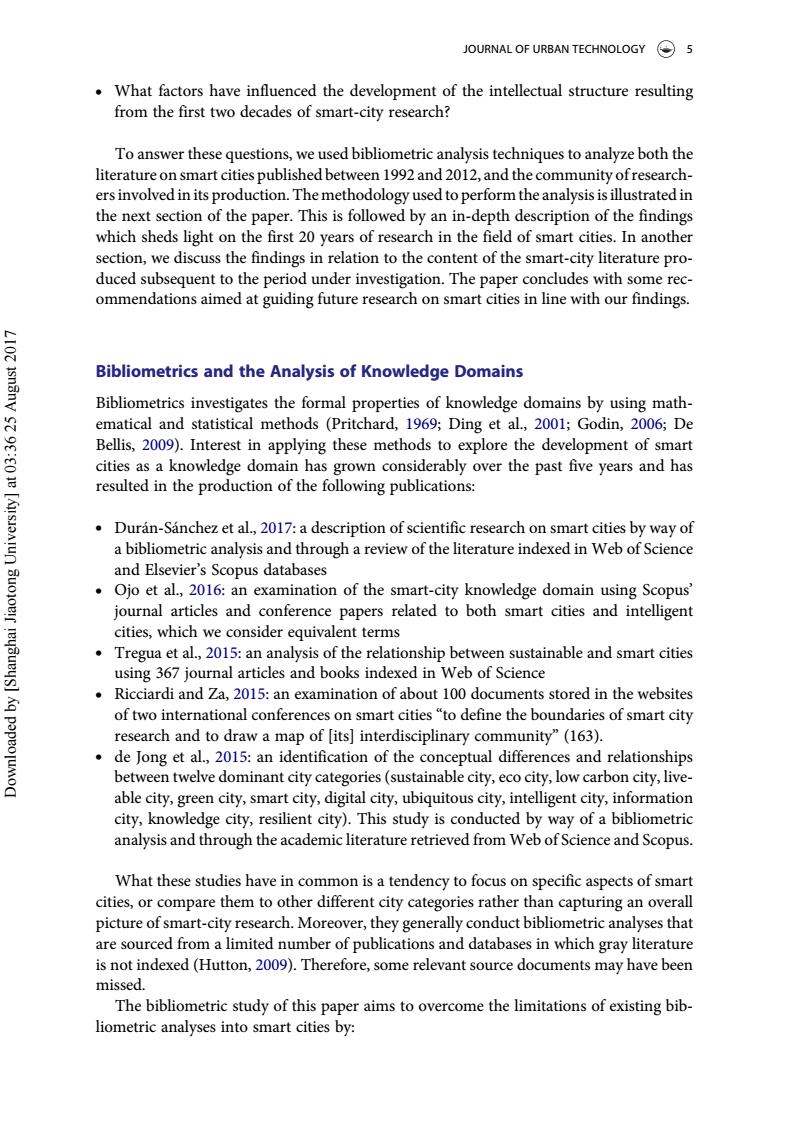正在加载图片...

JOURNAL OF URBAN TECHNOLOGY5 What factors have influenced the development of the intellectual structure resulting from the first two decades of smart-city research? To answer these questions,we used bibliometric analysis techniques to analyze both the literature on smart cities published between 1992 and 2012,and the community ofresearch- ers involved in its production.The methodology used to perform the analysis is illustrated in the next section of the paper.This is followed by an in-depth description of the findings which sheds light on the first 20 years of research in the field of smart cities.In another section,we discuss the findings in relation to the content of the smart-city literature pro- duced subsequent to the period under investigation.The paper concludes with some rec- ommendations aimed at guiding future research on smart cities in line with our findings. isnany Bibliometrics and the Analysis of Knowledge Domains Bibliometrics investigates the formal properties of knowledge domains by using math- 9 ematical and statistical methods (Pritchard,1969;Ding et al.,2001;Godin,2006;De Bellis,2009).Interest in applying these methods to explore the development of smart cities as a knowledge domain has grown considerably over the past five years and has resulted in the production of the following publications: Duran-Sanchez et al.,2017:a description of scientific research on smart cities by way of a bibliometric analysis and through a review of the literature indexed in Web of Science and Elsevier's Scopus databases uoloelf eyueyS] Ojo et al.,2016:an examination of the smart-city knowledge domain using Scopus' journal articles and conference papers related to both smart cities and intelligent cities,which we consider equivalent terms Tregua et al.,2015:an analysis of the relationship between sustainable and smart cities using 367 journal articles and books indexed in Web of Science 名 Ricciardi and za.2015:an examination of about 100 documents stored in the websites of two international conferences on smart cities "to define the boundaries of smart city apeojumo research and to draw a map of [its]interdisciplinary community"(163). de Jong et al.,2015:an identification of the conceptual differences and relationships between twelve dominant city categories(sustainable city,eco city,low carbon city,live- able city,green city,smart city,digital city,ubiquitous city,intelligent city,information city,knowledge city,resilient city).This study is conducted by way of a bibliometric analysis and through the academic literature retrieved from Web of Science and Scopus. What these studies have in common is a tendency to focus on specific aspects of smart cities,or compare them to other different city categories rather than capturing an overall picture of smart-city research.Moreover,they generally conduct bibliometric analyses that are sourced from a limited number of publications and databases in which gray literature is not indexed (Hutton,2009).Therefore,some relevant source documents may have been missed. The bibliometric study of this paper aims to overcome the limitations of existing bib- liometric analyses into smart cities by:. What factors have influenced the development of the intellectual structure resulting from the first two decades of smart-city research? To answer these questions, we used bibliometric analysis techniques to analyze both the literature on smart cities published between 1992 and 2012, and the community of researchers involved in its production. The methodology used to perform the analysis is illustrated in the next section of the paper. This is followed by an in-depth description of the findings which sheds light on the first 20 years of research in the field of smart cities. In another section, we discuss the findings in relation to the content of the smart-city literature produced subsequent to the period under investigation. The paper concludes with some recommendations aimed at guiding future research on smart cities in line with our findings. Bibliometrics and the Analysis of Knowledge Domains Bibliometrics investigates the formal properties of knowledge domains by using mathematical and statistical methods (Pritchard, 1969; Ding et al., 2001; Godin, 2006; De Bellis, 2009). Interest in applying these methods to explore the development of smart cities as a knowledge domain has grown considerably over the past five years and has resulted in the production of the following publications: . Durán-Sánchez et al., 2017: a description of scientific research on smart cities by way of a bibliometric analysis and through a review of the literature indexed in Web of Science and Elsevier’s Scopus databases . Ojo et al., 2016: an examination of the smart-city knowledge domain using Scopus’ journal articles and conference papers related to both smart cities and intelligent cities, which we consider equivalent terms . Tregua et al., 2015: an analysis of the relationship between sustainable and smart cities using 367 journal articles and books indexed in Web of Science . Ricciardi and Za, 2015: an examination of about 100 documents stored in the websites of two international conferences on smart cities “to define the boundaries of smart city research and to draw a map of [its] interdisciplinary community” (163). . de Jong et al., 2015: an identification of the conceptual differences and relationships between twelve dominant city categories (sustainable city, eco city, low carbon city, liveable city, green city, smart city, digital city, ubiquitous city, intelligent city, information city, knowledge city, resilient city). This study is conducted by way of a bibliometric analysis and through the academic literature retrieved from Web of Science and Scopus. What these studies have in common is a tendency to focus on specific aspects of smart cities, or compare them to other different city categories rather than capturing an overall picture of smart-city research. Moreover, they generally conduct bibliometric analyses that are sourced from a limited number of publications and databases in which gray literature is not indexed (Hutton, 2009). Therefore, some relevant source documents may have been missed. The bibliometric study of this paper aims to overcome the limitations of existing bibliometric analyses into smart cities by: JOURNAL OF URBAN TECHNOLOGY 5 Downloaded by [Shanghai Jiaotong University] at 03:36 25 August 2017